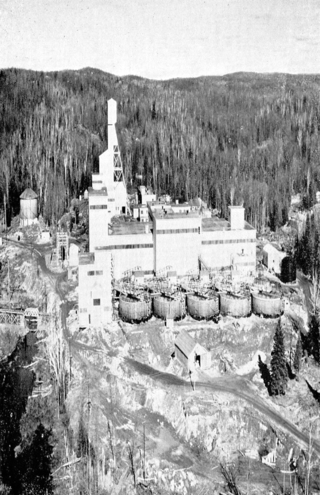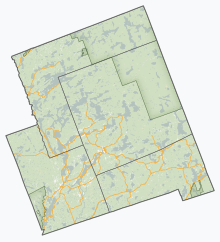
Ovintiv Inc. is an American independent petroleum company. The company was formed in 2020 through a restructuring of its Canadian predecessor, Encana. Ovintiv is incorporated in Delaware and headquartered in Denver, Colorado.

The Eldorado Mine is a defunct mine located in Port Radium, Northwest Territories, Canada. The site, which covers 12 hectares, is located next to Echo Bay in the shore of Great Bear Lake.

Highlands East is a township municipality located in Haliburton County, Ontario, Canada.
The Canadian Nuclear Safety Commission is the federal regulator of nuclear power and materials in Canada.

Madawaska Mine (previously known as Faraday Mine) is a decommissioned underground uranium mine in Faraday, near the town of Bancroft, Ontario, which produced 9 million pounds (4,082 tonnes) of U3O8 concentrate, at an average ore grade of 0.1074%, during its two periods of production.

Faraday is a township in the Canadian province of Ontario, located within Hastings County adjacent to the town of Bancroft.
The Pronto Mine is an historical uranium mine located approximately 20 km south of Elliot Lake, Ontario near Spragge. The site is owned and operated by Rio Algom Ltd, has been rehabilitated and is currently undergoing environmental monitoring.

Canada is the world's second-largest producer of uranium, behind Kazakhstan. In 2009, 20% of the world's primary uranium production came from mines in Canada. 14.5% of the world production came from one mine, McArthur River. Currently, the only producing area in Canada is northern Saskatchewan, although other areas have had active mines in the past.
The Agnew Lake Mine was a uranium mine located in the township of Hyman approximately 10 kilometres (6.2 mi) northeast of Agnew Lake, Ontario and 75 kilometres (47 mi) east of Elliot Lake, Ontario.

The successor of multiple historical Canadian mining and energy companies, EWL Management Limited was an Alberta based corporation that owned five decommissioned mines in Ontario, including three former uranium mines.

Bicroft Mine is a decommissioned underground uranium mine, located in Cardiff, near Bancroft, Ontario, Canada.

Greyhawk Mine is a decommissioned underground uranium mine located in Faraday Township near Bancroft, Ontario. It operated from 1954 to 1959 and from 1976 to 1982. The mine produced 80,247 tons of uranium ore, of which 0.069% was U3O8 worth $834,899.

Uranium mining around Bancroft, Ontario, was conducted at four sites, beginning in the early 1950s and concluding by 1982. Bancroft was one of two major uranium-producing areas in Ontario, and one of seven in Canada, all located along the edge of the Canadian Shield. In the context of mining, the "Bancroft area" includes Haliburton, Hastings, and Renfrew counties, and all areas between Minden and Lake Clear. Activity in the mid-1950s was described by engineer A. S. Bayne in a 1977 report as the "greatest uranium prospecting rush in the world".
Arthur Herbert Shore was a mineral prospector and the first person set up a uranium mine in Faraday Township, Ontario. He co-founded and managed the Reeves feldspar Mine and founded the Faraday Uranium Mine. His uranium prospecting, according to Bayne in 1977, led to the "greatest uranium prospecting rush in the world."
Coldstream Copper Mine, sometimes called the North Coldstream Copper Mine, the Coldstream Mine, or the North Coldstream Mine is a decommissioned former copper, silver and gold mine adjacent to Burchell Lake. It is located 11km south of Kashabowie, in Northern Ontario, Canada.
Gordon Lake Mine was an underground copper mine near Werner Lake in the Kenora District of Ontario Canada.

Uranium mining in the Elliot Lake area represents one of two major uranium-producing areas in Ontario, and one of seven in Canada.
The Fission Mine, previously known as the Richardson Deposit, is a fluoride and uranium deposit in Cardiff, near Wilberforce, Ontario, Canada.

Cardiff is a community in Highlands East, Ontario. It was incorporated in 1862, and became a uranium mining town during the late 1950s.













